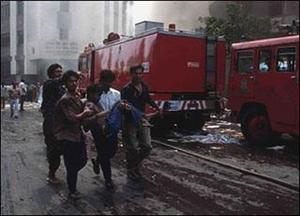LeaksLeak exposed valuable informant, jeopardized counter-terrorism efforts
Discussing the Justice Department’s effort to obtain telephone records of several AP journalists, sources close to the case say that the leak was deemed exceedingly egregious because it exposed an informant working for the U.K. and U.S. intelligence services, and who was able to achieve what other informants had not: the trust of the terrorists.

Leak jeopardises intelligence , leading to a sucessful attack, as with Naujrullah Zazi // Source: Dunya News
Discussing the Justice Department’s effort to obtain telephone records of several AP journalists, sources close to the case say that the leak was deemed exceedingly egregious because it exposed an informant working for the U.K. and U.S. intelligence services, and who was able to achieve what other informants had not: the trust of the terrorists.
The Los Angeles Times reports that information provided by the informant led directly to a successful drone strike on 6 May 2012, which killed senior al Qaeda leader Fahd Mohammed Ahmed Quso.
Quso was the mastermind behind the suicide bombing of the USS Cole in a Yemeni harbor in 2000. The bombing killed seventeen U.S. sailors and almost sank the ship.
The informant, in effort to learn more about al Qaeda method, persuaded members of Al Qaeda’s Yemeni affiliate to blow up a U.S. passenger jet — and volunteered to be the martyr. He was outfitted with an underwear bomb designed to beat metal detectors.
The informant did not blow up the plane: he left Yemen with the device and turned it over to his handlers. He wanted to go back to the terrorist cell – claiming that the device failed – in order to learn more about the organizations’ top bomb makers and their bomb-making methods.
Someone leaked the story to the AP, which ran a detailed expose of the operation, and the plan was foiled.. The Times notes that theAP did not mention the informant in the story, but other papers jumped on the story and by the next day, and several organizations named the informant.
“This was a bad, bad leak,” one official told the Times.
Attorney General Eric Holder described the leak as “within the top two or three most serious leaks that I have ever seen. It put the American people at risk.”
In a February, CIA director John Brennan called the publication of the information in the article an “unauthorized and dangerous disclosure of classified information.”
Brennan submitted a written testimony to Congress about the story, saying: “The irresponsible and damaging leak of classified information was made … when someone informed the Associated Press that the U.S. Government had intercepted an IED (improvised explosive device) that was supposed to be used in an attack and that the U.S. Government currently had that IED in its possession and was analyzing it,” he wrote.
Others question the assertions by Justice and the CIA.
“Any time you’ve got a human being involved who was compromised, it’s serious,”a former CIA lawyer, who asked not to be identified so he could express his opinion, told the Times. “But it certainly wasn’t one of the top two or three that I would have picked. And I never heard of a leak investigation throwing out a dragnet over this many reporters.”
